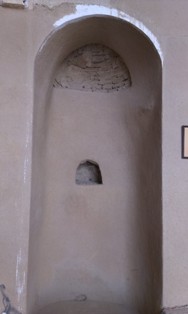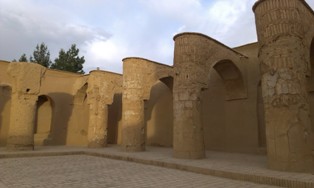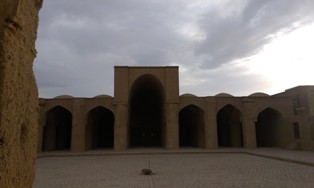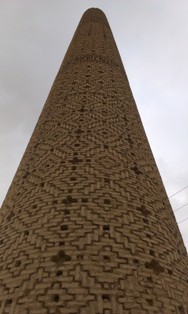Muslim conquests of Iran led to changes not only in political constitutions, but also in cultural structures. Associating with different religious structures, Islam brought about many social changes in the lives of Iranian people. Transformations in the functions of many social monuments are the inevitable consequences of these social changes.
The place of worship has always been considered one of the most significant social buildings. A mosque was the main social building of Muslims, with social and political functions. Tarikhane mosque which has unique architectural functions and structures is one of the oldest congressional mosques in Iran (Karimi, 2010, 98). Having been constructed on the foundations of pre-Islamic monuments has improved its position.
Regarding the architectural structure and function of the Tarikhane mosque, this article addresses the continuity and changes Tarikhane has undergone through time. It concludes that the architecture of the Tarikhane mosque has maintained its pre-Islamic function with minor changes in the structure.
Tarikhane mosque located to the south-east of Damghan was constructed in the 9th century (Godard, 1933, 109; Pirnia, 2005, 134). It was built with respect to the pre-Islamic Khurasani architectural design, which was common to the 11th century. ( Pirnia, 2005, 134).

Tarikhane mosque with a courtyard of 26/72 ms to 25/72 ms has been surrounded by 12/4 ms to 4/97 ms covered porches. The ceilings without walls and supported only by cylinders are the hallmark of Sassanian Empire architecture.
The mosque is called “chehel sotun” (forty columns) because of the intensity of its columns (Amin, 2001, 62). Tall columns and arches of Tarikhane Mosque are in the style of “the four porches or four pages”, which has the Sassanian characteristics. The part of the porch where the altar and pulpit are located is highlighted.

Clay and brick are the main materials of the Tarikhane mosque. Wood is used to strengthen arches and cylinders coated with plaster. Based on the Parthian and Sassanian styles, the bricks are stacked horizontally and vertically. Unlike other large buildings paved with stones or bricks, the floor of the central courtyard has been covered just with limestone and gypsum (Amin, 2001, 63). Excavating Tepe Hesar of Damghan, Eric Schmidt discovered some bricks of a Sassanian palace that looked like the bricks of the Tarikhane mosque (Schmidt, Erich, 1937, pp. 12-16).

Minaret as a pre-Islamic construction guided the travelers and caravans along roads. In the Islamic era, minarets were also used to call Muslims to pray (azan) (Amin, 2001, 62). Minaret of Tarikhane like the Fahraj and Nai’en congregational mosques is one of the oldest round Iranian minarets (Karimi, 2010, 98; Vilson, 1987, vol 2, 158). Regarding its Kufic inscription, the minaret with 26 ms height and 86 stairs was constructed in the Saljuq era under the command of Bakhtiar ibn Muhammad the ruler of Qumes (Karimi, 2010, 98).

It has been decorated with geometric designs. Each of these geometric shapes is composed of seven ties as a symbol of mystical completion (Amin, 2001, 62, Shareq, 1968, 19).
Architectural styles and even the name of monuments such as Tarikhane indicate changes and continuity of architectural structures and functions. The Turkish or Tukeman word tari means God, therefore, Tarikhane means God’s home (Amin, 2001, 61). Even though this mosque was built in the 11th century, it was reconstructed during the reigns of the Qaznavids and Saljuqs and so its name changed to Tarikhane (ibid). Some researchers believe that Tarikhane had been a fire temple in the pre-Islamic era and after the Arab conquest of Iran, it changed into a mosque (Shareq, 1968, 17; Karimi, 2010, 95; Berand, 2007, 70-71).
Some other researchers look for the origins of its name in architectural styles. Regarding its similarities to the Sassanian palaces, these researchers believe that the word khoda which had changed to tari in later eras originally refers to the word shah (king). In this respect, tarikhane meant the King's home in the pre-Islamic era and so it maintained its name after changing to mosque (Amin, 2001, 61).
Structural changes of Tarikhane from the palace or the fire temple to the mosque were not fundamental changes and according to archaeological evidence and written sources, Tarikhane was reconstructed with surface modifications.
Considering its holiness, Tarikhane has continued its architectural function. Places of worship in all religions like Zoroastrianism and Islam were highly honored. Accepting the hypothesis that Tarikhane was originally a fireplace, it has maintained its religious and social functions as the place of worship. Furthermore, the sacristy of kings in the Iranian culture and their Farah-e izadi (divine splendor) give them special dignity. In many historic and literal sources, the word khoda referred to kings. In the light of the fact that Tarikhane mosque was once a Sassanian royal palace and given the fact that mosques are built in sacred places, Tarikhane has retained its dignity. In short, if we consider the sacristy of a place as its function, Tarikhane has continued its function by transforming from a pre-Islamic palace to an Islamic mosque.
Maryam Kamali
References
Pirnia, Muhammad Karim (2005). Sabkshenasi, Me’mari-ye Iranian, Tehran: Me’mar.
Vilson, Kristi (1987). Tarikh-e San’at Iran, tr. Abdollah Faryar, Tehran: Farhangsara.
Hillenbrand, Robert (2007). Me’mari-ye Eslami, tr. Iraj E’tesam, Tehran: Shahdari-ye Tehran.
Amin, Seyed Hassan, “Masjed-e tarikhane-ye Damghan”. Honar, 2001, n 31-32, pp.61-63.
Shareq, Ahmad, “Tarikhane, Ma’bad-e Tarikhane-ye Iran, Helan”, 1968, n 85, pp. 17-19.
Karimi, Ali Reza, “Daramadi bar Me’mari-ye Nakhostin Masajed ba Nazar be Tarikhane-ye Damghan, Honar”, 2010, n 141, pp. 92-99.
Godard, Andre, “Tarikhane-ye Damghan, Honar va Me’mari”, 1933, n2, pp. 101-109.
Afsharfar, Nasser, “Masjed-e Tarikhane-ye Damghan”, Masjed-e 33, 1997, pp. 86-93.
Schmidt, Erich, “Excavations at Tepe Hissar”, Philadelphia, The University of Pennsylvania Press, 1937, pp. 12-16.
